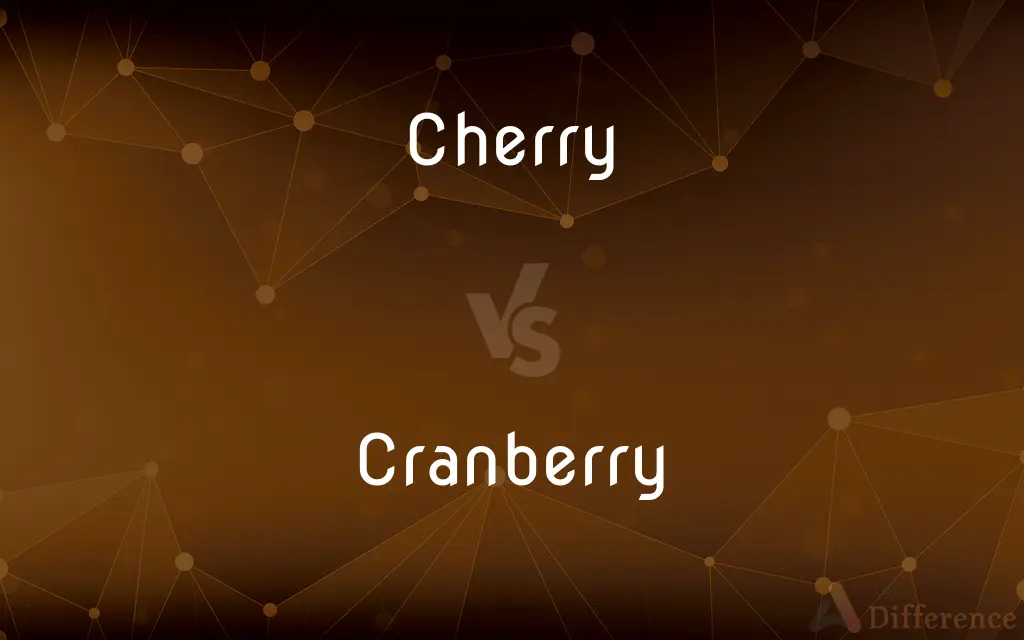Cherry vs. Cranberry — What's the Difference?
By Maham Liaqat & Fiza Rafique — Updated on March 14, 2024
Cherries are sweet or tart stone fruits, while cranberries are tart, small berries known for urinary tract health benefits.

Difference Between Cherry and Cranberry
Table of Contents
ADVERTISEMENT
Key Differences
Cherries are fleshy stone fruits from the genus Prunus, enjoyed for their sweet or tart flavors and often eaten fresh or used in desserts. Cranberries, on the other hand, are small, tart berries that belong to the genus Vaccinium.
Cherries thrive in temperate regions and have a short harvest season, typically in the summer, whereas cranberries are cultivated in cooler climates, often in bogs or wetlands, and are harvested in the fall.
While cherries can be consumed fresh, directly off the tree, cranberries are usually processed into products or cooked with sugar to mitigate their natural tartness.
Both fruits offer nutritional benefits but differ significantly in taste and texture; cherries are soft and juicy, while cranberries are firm and tart. This distinction influences their culinary applications and consumer preferences.
Comparison Chart
Type
Stone fruit
Berry
ADVERTISEMENT
Taste
Sweet or tart
Tart
Consumption
Fresh, desserts, jams
Juices, sauces, dried
Health Benefits
Antioxidants, anti-inflammatory
UTI prevention, antioxidants
Harvest Season
Summer
Fall
Compare with Definitions
Cherry
Stone Fruit.
Cherries are stone fruits, characterized by a single large seed encased within their juicy flesh.
Cranberry
Berry.
Cranberries are small, tart berries often harvested in water-flooded bogs.
Cherry
Culinary Uses.
Cherries can be eaten fresh or used in a variety of desserts like cherry pie.
Cranberry
UTI Prevention.
Cranberries contain compounds that can prevent urinary tract infections.
Cherry
Tart Variety.
Tart cherries, such as Montmorency, are often used in pies and jams.
Cranberry
Harvest Method.
Cranberries are typically harvested using a method that floods the bog, allowing the berries to float for easy collection.
Cherry
Health Benefits.
Cherries are rich in antioxidants, making them beneficial for reducing inflammation.
Cranberry
Tart Flavor.
Due to their tartness, cranberries are rarely eaten raw and usually sweetened.
Cherry
Sweet Variety.
Sweet cherries, like Bing cherries, are enjoyed fresh due to their sugary flavor.
Cranberry
Culinary Uses.
Cranberries are commonly used to make cranberry sauce for Thanksgiving.
Cherry
A cherry is the fruit of many plants of the genus Prunus, and is a fleshy drupe (stone fruit). Commercial cherries are obtained from cultivars of several species, such as the sweet Prunus avium and the sour Prunus cerasus.
Cranberry
Cranberries are a group of evergreen dwarf shrubs or trailing vines in the subgenus Oxycoccus of the genus Vaccinium. In Britain, cranberry may refer to the native species Vaccinium oxycoccos, while in North America, cranberry may refer to Vaccinium macrocarpon.
Cherry
Any of various trees or shrubs of the genus Prunus of the rose family, especially the sweet cherry or the sour cherry, native chiefly to northern temperate regions and having pink or white flowers and small juicy drupes.
Cranberry
A mat-forming, evergreen shrub (Vaccinium macrocarpon) in the heath family, native to eastern North America and widely cultivated for its tart, red, edible berries.
Cherry
The yellow, red, or blackish fruit of any of these plants.
Cranberry
The berries of this plant, used in sauces, jellies, relishes, and beverages.
Cherry
The wood of any of these plants, especially the black cherry.
Cranberry
Any of several other plants in the genus Vaccinium having red berries, especially V. oxycoccos.
Cherry
Any of various plants, such as the Barbados cherry or the cornelian cherry, having fruits resembling a cherry.
Cranberry
(countable) A shrub belonging to the section Vaccinium sect. Oxycoccus of the genus Vaccinium.
Cherry
A moderate or strong red to purplish red.
Cranberry
(countable) The edible red berry of that shrub.
Cherry
Vulgar Slang The hymen considered as a symbol of virginity.
Cranberry
An intense red colour, like that of a cranberry
Cherry
Containing or having the flavor of cherries.
Cranberry
Of the intense red colour of a cranberry.
Cherry
Made of the wood of a cherry tree
A cherry cabinet.
Cranberry
A red, acid berry, much used for making sauce, etc.; also, the plant producing it (several species of Vaccinum or Oxycoccus.) The high cranberry or cranberry tree is a species of Viburnum (Viburnum Opulus), and the other is sometimes called low cranberry or marsh cranberry to distinguish it.
Cherry
Of a moderate or strong red to purplish red.
Cranberry
Any of numerous shrubs of genus Vaccinium bearing cranberries
Cherry
A small fruit, usually red, black or yellow, with a smooth hard seed and a short hard stem.
Cranberry
Very tart red berry used for sauce or juice
Cherry
Prunus subg. Cerasus, trees or shrubs that bear cherries.
Cherry
The wood of a cherry tree.
Cherry
(color) Cherry red.
Cherry
The fruit of the coffee plant, containing the seeds or beans.
Cherry
(slang) Virginity, especially female virginity as embodied by a hymen.
Cherry
(graph theory) A subtree consisting of a node with exactly two leaves.
Cherry
A cricket ball.
Cherry
A round, red light of the kind that is typically mounted on top of a police car.
Cherry
The burning tip of a cigarette.
Cherry
Containing or having the taste of cherries.
Cherry
Of a bright red colour; cherry red.
Cherry
In excellent condition; mint condition.
Cherry
A tree or shrub of the genus Prunus (Which also includes the plum) bearing a fleshy drupe with a bony stone;
Cherry
The fruit of the cherry tree, a drupe of various colors and flavors.
Cherry
The timber of the cherry tree, esp. of the black cherry, used in cabinetmaking, etc.
Cherry
A peculiar shade of red, like that of a cherry.
Cherry
Like a red cherry in color; ruddy; blooming; as, a cherry lip; cherry cheeks.
Cherry
Wood of any of various cherry trees especially the black cherry
Cherry
Any of numerous trees and shrubs producing a small fleshy round fruit with a single hard stone; many also produce a valuable hardwood
Cherry
Fruit with a single hard stone
Cherry
A red the color of ripe cherries
Common Curiosities
What distinguishes a cherry from a cranberry?
Cherries are stone fruits with a sweet or tart flavor, whereas cranberries are tart berries known for their health benefits.
What are the health benefits of cherries?
Cherries offer antioxidants and anti-inflammatory benefits.
Can cherries and cranberries be eaten raw?
Cherries can be enjoyed raw, while cranberries are usually too tart to eat raw and are often sweetened or processed.
What are cranberries good for?
Cranberries are beneficial for preventing urinary tract infections and also offer antioxidant properties.
Are cherries and cranberries used differently in cooking?
Yes, cherries are used fresh or in desserts, while cranberries are used in sauces, juices, and as dried fruits.
When are cherries harvested?
Cherries are harvested in the summer.
When are cranberries harvested?
Cranberries are harvested in the fall.
Which is sweeter, cherries or cranberries?
Cherries are generally sweeter than cranberries.
Are cherry stems edible?
Cherry stems are not commonly eaten, though they are not harmful.
Can cherries help with sleep?
Yes, cherries contain melatonin, which can aid sleep.
Do cranberries need to be cooked?
Cranberries are often cooked or processed due to their tartness.
What makes cranberries float during harvest?
Cranberries have air pockets that make them float when bogs are flooded.
Are dried cherries as healthy as fresh?
Dried cherries still offer health benefits but may contain added sugars.
Can you substitute cherries for cranberries in recipes?
You can substitute them based on taste preference, but the flavor profile will change.
What is the main antioxidant in cherries?
Anthocyanins are the main antioxidants in cherries.
Share Your Discovery

Previous Comparison
Case vs. Example
Next Comparison
Fact vs. ArgumentAuthor Spotlight
Written by
Maham LiaqatCo-written by
Fiza RafiqueFiza Rafique is a skilled content writer at AskDifference.com, where she meticulously refines and enhances written pieces. Drawing from her vast editorial expertise, Fiza ensures clarity, accuracy, and precision in every article. Passionate about language, she continually seeks to elevate the quality of content for readers worldwide.
















































